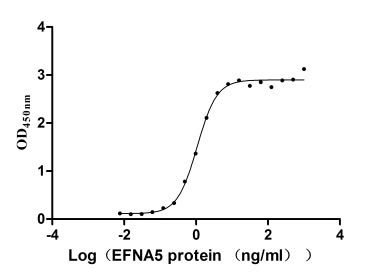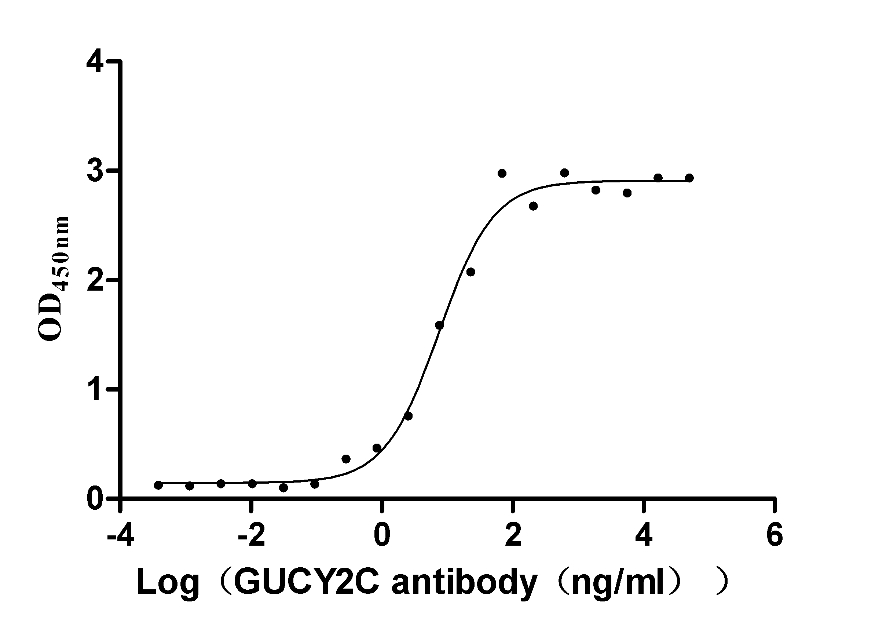Recombinant Human SARS coronavirus Replicase polyprotein 1a (1a), partial
-
货号:CSB-YP315160HQE
-
规格:
-
来源:Yeast
-
其他:
-
货号:CSB-EP315160HQE
-
规格:
-
来源:E.coli
-
其他:
-
货号:CSB-EP315160HQE-B
-
规格:
-
来源:E.coli
-
共轭:Avi-tag Biotinylated
E. coli biotin ligase (BirA) is highly specific in covalently attaching biotin to the 15 amino acid AviTag peptide. This recombinant protein was biotinylated in vivo by AviTag-BirA technology, which method is BriA catalyzes amide linkage between the biotin and the specific lysine of the AviTag.
-
其他:
-
货号:CSB-BP315160HQE
-
规格:
-
来源:Baculovirus
-
其他:
-
货号:CSB-MP315160HQE
-
规格:
-
来源:Mammalian cell
-
其他:
产品详情
-
纯度:>85% (SDS-PAGE)
-
基因名:1a
-
Uniprot No.:
-
别名:1a; Replicase polyprotein 1a; pp1a; ORF1a polyprotein) [Cleaved into: Non-structural protein 1; nsp1; Leader protein); Non-structural protein 2; nsp2; p65 homolog); Non-structural protein 3; nsp3; EC 3.4.19.12; EC 3.4.22.69; PL2-PRO; Papain-like proteinase; PL-PRO; SARS coronavirus main proteinase); Non-structural protein 4; nsp4); 3C-like proteinase; 3CL-PRO; 3CLp; EC 3.4.22.-; nsp5); Non-structural protein 6; nsp6); Non-structural protein 7; nsp7); Non-structural protein 8; nsp8); Non-structural protein 9; nsp9); Non-structural protein 10; nsp10; Growth factor-like peptide; GFL); Non-structural protein 11; nsp11)]
-
种属:Human SARS coronavirus (SARS-CoV) (Severe acute respiratory syndrome coronavirus)
-
蛋白长度:Partial
-
蛋白标签:Tag type will be determined during the manufacturing process.
The tag type will be determined during production process. If you have specified tag type, please tell us and we will develop the specified tag preferentially. -
产品提供形式:Lyophilized powder
Note: We will preferentially ship the format that we have in stock, however, if you have any special requirement for the format, please remark your requirement when placing the order, we will prepare according to your demand. -
复溶:We recommend that this vial be briefly centrifuged prior to opening to bring the contents to the bottom. Please reconstitute protein in deionized sterile water to a concentration of 0.1-1.0 mg/mL.We recommend to add 5-50% of glycerol (final concentration) and aliquot for long-term storage at -20℃/-80℃. Our default final concentration of glycerol is 50%. Customers could use it as reference.
-
储存条件:Store at -20°C/-80°C upon receipt, aliquoting is necessary for mutiple use. Avoid repeated freeze-thaw cycles.
-
保质期:The shelf life is related to many factors, storage state, buffer ingredients, storage temperature and the stability of the protein itself.
Generally, the shelf life of liquid form is 6 months at -20°C/-80°C. The shelf life of lyophilized form is 12 months at -20°C/-80°C. -
货期:Delivery time may differ from different purchasing way or location, please kindly consult your local distributors for specific delivery time.Note: All of our proteins are default shipped with normal blue ice packs, if you request to ship with dry ice, please communicate with us in advance and extra fees will be charged.
-
注意事项:Repeated freezing and thawing is not recommended. Store working aliquots at 4°C for up to one week.
-
Datasheet :Please contact us to get it.
靶点详情
-
功能:Multifunctional protein involved in the transcription and replication of viral RNAs. Contains the proteinases responsible for the cleavages of the polyprotein.; Inhibits host translation by interacting with the 40S ribosomal subunit. The nsp1-40S ribosome complex further induces an endonucleolytic cleavage near the 5'UTR of host mRNAs, targeting them for degradation. Viral mRNAs are not susceptible to nsp1-mediated endonucleolytic RNA cleavage thanks to the presence of a 5'-end leader sequence and are therefore protected from degradation. By suppressing host gene expression, nsp1 facilitates efficient viral gene expression in infected cells and evasion from host immune response. May disrupt nuclear pore function by binding and displacing host NUP93.; May play a role in the modulation of host cell survival signaling pathway by interacting with host PHB and PHB2. Indeed, these two proteins play a role in maintaining the functional integrity of the mitochondria and protecting cells from various stresses.; Responsible for the cleavages located at the N-terminus of the replicase polyprotein. In addition, PL-PRO possesses a deubiquitinating/deISGylating activity and processes both 'Lys-48'- and 'Lys-63'-linked polyubiquitin chains from cellular substrates. Plays a role in host membrane rearrangement that leads to creation of cytoplasmic double-membrane vesicles (DMV) necessary for viral replication. Nsp3, nsp4 and nsp6 together are sufficient to form DMV. Antagonizes innate immune induction of type I interferon by blocking the phosphorylation, dimerization and subsequent nuclear translocation of host IRF3. Prevents also host NF-kappa-B signaling.; Plays a role in host membrane rearrangement that leads to creation of cytoplasmic double-membrane vesicles (DMV) necessary for viral replication. Alone appears incapable to induce membrane curvature, but together with nsp3 is able to induce paired membranes. Nsp3, nsp4 and nsp6 together are sufficient to form DMV.; Cleaves the C-terminus of replicase polyprotein at 11 sites. Recognizes substrates containing the core sequence Plays a role in host membrane rearrangement that leads to creation of cytoplasmic double-membrane vesicles (DMV) necessary for viral replication. Nsp3, nsp4 and nsp6 together are sufficient to form DMV. Plays a role in the initial induction of autophagosomes from host reticulum endoplasmic. Later, limits the expansion of these phagosomes that are no longer able to deliver viral components to lysosomes.; Forms a hexadecamer with nsp8 (8 subunits of each) that may participate in viral replication by acting as a primase. Alternatively, may synthesize substantially longer products than oligonucleotide primers.; Forms a hexadecamer with nsp7 (8 subunits of each) that may participate in viral replication by acting as a primase. Alternatively, may synthesize substantially longer products than oligonucleotide primers.; Plays an essential role in viral replication by forming a homodimer that binds single-stranded RNA.; Plays a pivotal role in viral transcription by stimulating both nsp14 3'-5' exoribonuclease and nsp16 2'-O-methyltransferase activities. Therefore plays an essential role in viral mRNAs cap methylation.
-
基因功能参考文献:
- Data indicate cellular E3 ubiquitin ligase ring-finger and CHY zinc-finger domain-containing 1 (RCHY1) as an interacting partner of the viral SARS-unique domain (SUD) and papain-like protease (PL(pro)), and, as a consequence, the involvement of cellular p53 as antagonist of coronaviral replication. PMID: 27519799
- Finally, the s showed that loss of the nsp3-nsp4 interaction eliminated viral replication by using an infectious cDNA clone and replicon system of SARS coronavirus. PMID: 28738245
- Report specificity of Lys48-linked di-ubiquitin and deubiquitinating activities of the SARS coronavirus papain-like protease. PMID: 27203180
- While the SUD-N and the X domains were found to be dispensable, the SUD-M domain of nsp3 protein was crucial for viral genome replication/transcription. PMID: 26149721
- analysis of the architecture of the nsp14-nsp10 complex involved in RNA viral proofreading PMID: 26159422
- The data show that SARS coronavirus PLpro also inhibits IRF3 activation at a step after phosphorylation and that this inhibition is dependent on the de-ubiquitination (DUB) activity of PLpro. PMID: 25481026
- identification of sites in PLpro required for recognition and processing of diubiquitin and ISG15 provides insight into ubiquitin-chain and ISG15 recognition and highlights role for PLpro DUB and deISGylase activity in antagonism of innate immune response PMID: 24854014
- Molecular simulations lead to the conclusion that zwitterion formation is fostered by substrate binding to the catalytic Cys-His dyad of the SARS-CoV main protease. PMID: 25196915
- The maturation of the SARS coronavirus polyprotein is influnced by the N- and C-terminal pro-sequences of the 3C-like protease. PMID: 23452147
- a new mechanism used by CoVs in which CoV PLPs negatively regulate antiviral defenses by disrupting the STING-mediated IFN induction [PLP] PMID: 22312431
- the covalent linkage between the chymotrypsin like and the extra domain is essential for enzymatic activity of the main coronavirus protease and for the integrity of its quaternary structure. PMID: 20587646
- We have built a homology model of the SARS polymerase using the 3D jury system; a homology model based on the amino acid sequence can provide some clues concerning the residues critical for its function. PMID: 15326590
- cloning, expression, and purification of the N-terminal GST-fused SARS-CoV RNA-dependent RNA polymerase and its catalytic domain in Escherichia coli PMID: 15840516
- this is the first report of the interaction between the ORF6 SARS-CoV accessory protein and nsp8 and our findings suggest that ORF6 protein may play a role in virus replication. PMID: 17532020
- The membrane topology, processing, and subcellular localization of nsp4 of severe acute respiratory syndrome-associated coronavirus (SARS-CoV) were elucidated in this study. PMID: 17855519
- dimerization appears to be coupled to catalysis in 3CLpro through the use of overlapped residues for two networks, one for dimerization and another for the catalysis PMID: 18305031
- Together, these data indicate that dimerization of SARS-CoV nsp9 at the GXXXG motif is not critical for RNA binding but is necessary for viral replication. PMID: 19153232
- the Ddx5 (Asp-Glu-Ala-Asp box polypeptide 5) protein showed specific interaction with SARS-CoV helicase. PMID: 19224332
- crystal structures of fragment 389-652 - SARS-unique domain (SUD)(core) - of Nsp3, which comprises 264 of the 338 residues of the domain; entire SUD(core) as well as individual subdomains interact with oligonucleotides known to form G-quadruplexes PMID: 19436709
显示更多
收起更多
-
亚细胞定位:[Non-structural protein 2]: Host cytoplasm. Host endosome.; [Papain-like protease nsp3]: Host membrane; Multi-pass membrane protein. Host cytoplasm.; [Non-structural protein 4]: Host membrane; Multi-pass membrane protein. Host cytoplasm.; [3C-like proteinase nsp5]: Host cytoplasm. Host Golgi apparatus.; [Non-structural protein 6]: Host membrane; Multi-pass membrane protein.; [Non-structural protein 7]: Host cytoplasm, host perinuclear region. Host cytoplasm. Host endoplasmic reticulum. Note=nsp7, nsp8, nsp9 and nsp10 are localized in cytoplasmic foci, largely perinuclear. Late in infection, they merge into confluent complexes.; [Non-structural protein 8]: Host cytoplasm, host perinuclear region. Host cytoplasm. Host endoplasmic reticulum. Note=nsp7, nsp8, nsp9 and nsp10 are localized in cytoplasmic foci, largely perinuclear. Late in infection, they merge into confluent complexes.; [Non-structural protein 9]: Host cytoplasm, host perinuclear region. Host cytoplasm. Host endoplasmic reticulum. Note=nsp7, nsp8, nsp9 and nsp10 are localized in cytoplasmic foci, largely perinuclear. Late in infection, they merge into confluent complexes.; [Non-structural protein 10]: Host cytoplasm, host perinuclear region. Host cytoplasm. Host endoplasmic reticulum. Note=nsp7, nsp8, nsp9 and nsp10 are localized in cytoplasmic foci, largely perinuclear. Late in infection, they merge into confluent complexes.
-
蛋白家族:Coronaviruses polyprotein 1ab family
Most popular with customers
-
Recombinant Human Ephrin type-A receptor 3 (EPHA3), partial (Active)
Express system: Mammalian cell
Species: Homo sapiens (Human)
-
Recombinant Human Heat-stable enterotoxin receptor (GUCY2C), partial (Active)
Express system: Mammalian cell
Species: Homo sapiens (Human)
-
Recombinant Macaca fascicularis Claudin (CLDN18)-VLPs (Active)
Express system: Mammalian cell
Species: Macaca fascicularis (Crab-eating macaque) (Cynomolgus monkey)
-
Recombinant Human Claudin-9 (CLDN9)-VLPs (Active)
Express system: Mammalian cell
Species: Homo sapiens (Human)
-
Recombinant Human Dickkopf-related protein 1 (DKK1) (Active)
Express system: Mammalian cell
Species: Homo sapiens (Human)
-
Recombinant Human CUB domain-containing protein 1 (CDCP1), partial (Active)
Express system: Mammalian cell
Species: Homo sapiens (Human)
-
Recombinant Human Serotransferrin(TF) (Active)
Express system: Mammalian cell
Species: Homo sapiens (Human)
-
Recombinant Macaca fascicularis C-type lectin domain family 4 member C(CLEC4C), partial (Active)
Express system: Mammalian cell
Species: Macaca fascicularis (Crab-eating macaque) (Cynomolgus monkey)






-AC1.jpg)













